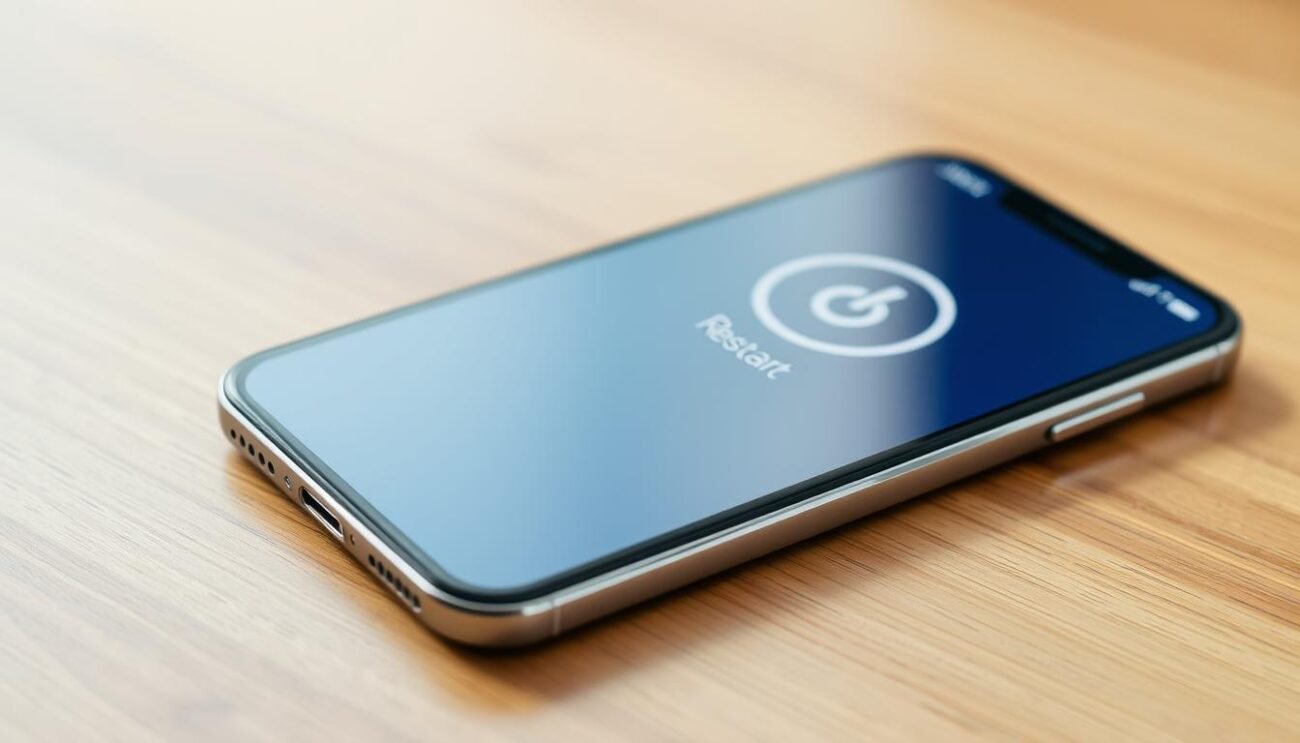In today’s fast-paced digital world, our smartphones have become an integral part of our daily lives. However, even the most advanced devices can sometimes experience hiccups or slow down, leaving us frustrated and searching for a solution. But fear not, for the humble mobile restart can often be the key to reviving your phone’s performance and getting it back on track.
Have you ever wondered why your device seems to slow down over time or encounter unexpected issues? The answer may lie in the simple act of restarting your phone. But how exactly do you go about it, and what are the benefits of this oft-overlooked maintenance task? Let’s dive in and explore the secrets of the mobile restart, unlocking the full potential of your smartphone.
- Understand the importance of regular phone reboots for optimal performance and battery life
- Discover the different types of mobile restart methods, from soft resets to force restarts
- Learn step-by-step procedures for restarting Android and iOS devices
- Explore the benefits of using safe mode and troubleshoot common restart-related issues
- Discover best practices for maintaining your phone’s health through proper restart techniques
Understanding the Importance of Phone Restarts
In the fast-paced digital world, our mobile devices have become essential companions, aiding us in countless ways throughout the day. However, even these marvels of modern technology can benefit from a periodic mobile reboot or reset. Recognizing the common signs that your phone needs a restart and understanding the benefits of regular device rebooting can significantly impact your phone’s performance and battery life. Check out this quick guide for every device, for a detailed guide on rebooting your device.
Common Signs Your Phone Needs a Restart
There are several telltale signs that indicate your phone could use a restart phone:
- Sluggish performance or lagging applications
- Unresponsive or freezing screen
- Excessive battery drain or overheating
- Persistent connectivity issues, such as poor Wi-Fi or cellular reception
Benefits of Regular Device Rebooting
Regularly rebooting your mobile device can provide numerous benefits, including:
- Improved performance: A mobile reboot can clear the device’s memory, allowing it to run more efficiently and responsively.
- Enhanced battery life: Rebooting can help optimize power consumption and prevent battery-draining issues.
- Troubleshooting: A reset mobile can often resolve minor software glitches and system errors.
- Increased security: Rebooting can help protect your device from potential vulnerabilities by refreshing the operating system.
Impact on Phone Performance and Battery Life
Neglecting to restart phone can lead to a gradual decline in your device’s performance and battery life. Cached data, background processes, and other system issues can accumulate over time, causing your phone to slow down and drain its battery more quickly. By making mobile reboot a part of your regular maintenance routine, you can help ensure your device runs at its best and lasts longer on a single charge.
Different Types of Mobile Restart Methods
When it comes to rebooting your mobile device, there are several methods you can employ, each with its own purpose and application. From the basic soft reset to the more advanced force restart and safe mode restart, understanding these techniques can help you troubleshoot a wide range of issues and keep your phone running smoothly.
Soft Reset
A soft reset is the most common and straightforward way to restart your phone. It simply involves powering off the device and then turning it back on, allowing the operating system to refresh and clear any temporary glitches or minor software issues. This method is often the first step in resolving common problems, such as app crashes, slow performance, or frozen screens.
Force Restart
A force restart, also known as a hard reset, is a more forceful method of restarting your device. This technique is typically used when a soft reset fails to resolve the issue or when your phone is completely unresponsive. By pressing and holding a specific combination of buttons, you can force the device to shut down and restart, potentially fixing more serious software-related problems.
Safe Mode Restart
The safe mode restart is a special restart process that boots your phone into a diagnostic mode, where only the essential system components are loaded. This method is particularly useful for troubleshooting issues related to third-party apps or software conflicts, as it allows you to identify and address the root cause of the problem without the interference of additional installed applications.
Understanding the differences between these restart methods and when to use them can be the key to quickly resolving a wide range of mobile device issues, from performance problems to software glitches. Familiarize yourself with these techniques to ensure your phone is always running at its best.
Standard Soft Reset Procedures for Android Devices
If your Android device is experiencing performance issues or software-related problems, a simple soft reset can often resolve the issue. A soft reset, also known as a restart, is a quick and easy way to refresh your device without losing any of your data or settings. Here’s a step-by-step guide on how to perform a soft reset on various Android devices.
Steps for Samsung Devices
- Press and hold the Power button on your Samsung device.
- Tap the “Restart” option from the menu that appears.
- Wait for your device to power down and then restart automatically.
Steps for Google Pixel Phones
- Press and hold the Power button on your Google Pixel phone.
- Tap the “Restart” option from the menu that appears.
- Wait for your device to power down and then restart automatically.
Steps for Other Android Manufacturers
The process for performing a soft reset on other Android devices may vary slightly, but the general steps are similar:
- Locate the Power button on your Android device.
- Press and hold the Power button until a menu appears.
- Tap the “Restart” or “Reboot” option from the menu.
- Wait for your device to power down and then restart automatically.
Regardless of the Android manufacturer, a soft reset is a quick and easy way to address a wide range of software-related issues, from app crashes to performance problems. By regularly restarting your Android device, you can help maintain its optimal performance and extend its battery life.
Quick Mobile Restart Solutions for iPhones
In the world of smartphones, iPhones have long been known for their user-friendly interface and seamless performance. However, even these devices can occasionally encounter hiccups that require a quick restart to get them back on track. Fortunately, there are several straightforward solutions to restart your iPhone and get it running smoothly again.
For older iPhone models, such as the iPhone 6 or earlier, the soft reset process may differ slightly. In these cases, you’ll need to press and hold the power button and the home button until the Apple logo appears.
If a standard soft reset doesn’t resolve the issue, you may need to try a force restart, also known as a restart iOS or iPhone reboot. This more forceful approach can be useful when your device is frozen or unresponsive. To force restart an iPhone, press and quickly release the volume up button, then press and quickly release the volume down button, and finally press and hold the power button until the Apple logo appears.

By understanding these quick mobile restart solutions for iPhones, you can quickly troubleshoot and address any software-related problems that may arise, keeping your device running at its best.
How to Force Restart When Your Phone is Frozen
Occasionally, our mobile devices may become unresponsive or frozen, leaving us with no choice but to resort to a force restart. This emergency procedure can be a lifesaver when your phone refuses to respond to standard restart methods. Let’s explore the steps to force restart your device and troubleshoot common issues.
Emergency Restart Procedures
To force restart a frozen Android device, follow these steps:
- Press and hold the Power button and the Volume Down button simultaneously for 10-15 seconds.
- Release the buttons when the device starts to vibrate or the manufacturer’s logo appears.
- Wait for the device to fully restart and ensure it’s functioning properly.
For iPhones, the process is slightly different:
- Press and quickly release the Volume Up button.
- Press and quickly release the Volume Down button.
- Press and hold the Side button until the device restarts.
When to Use Force Restart
A force restart should be considered as a last resort when your phone is completely frozen and unresponsive to standard restart methods. This may happen due to software glitches, hardware issues, or unexpected app crashes. Knowing when to use a force restart can help you regain control of your device and prevent further issues. For more tips on restarting your phone effectively, refer to this quick guide to phone restart tips.
Troubleshooting Common Issues
If a force restart doesn’t resolve the problem, there are a few additional steps you can take:
- Check for software updates: Ensure your device is running the latest version of the operating system, as updates often address bug fixes and performance improvements.
- Clear app cache and data: Cached data and app-related issues can sometimes cause freezing or unresponsiveness. Try clearing the cache or data for problematic apps.
- Perform a factory reset: As a last resort, consider performing a factory reset, which will erase all data and settings on your device. Back up your important data before attempting this.
Remember, a force restart should be used cautiously and as a temporary solution. If the issue persists or you encounter other problems, it’s best to seek professional help to ensure your device is functioning correctly.
Safe Mode Restart: When and How to Use It
Your smartphone can sometimes encounter software-related issues that require special troubleshooting techniques. One such method is the safe mode restart, which can be a valuable tool in diagnosing and resolving certain problems with your device.
The safe mode reboot is a diagnostic mode that loads your phone’s operating system with only the essential default settings and services, bypassing any third-party apps or customizations. This allows you to identify whether an issue is being caused by a specific app or by a deeper system problem.
Benefits of Safe Mode Restart
- Helps isolate software-related issues by running your phone in a stripped-down, basic state
- Allows you to safely uninstall problematic apps or perform other troubleshooting steps
- Can improve device performance and battery life by disabling unnecessary background processes
- Provides a safe environment to restart in safe mode and test your phone’s functionality
How to Restart in Safe Mode
The process for entering safe mode varies slightly between Android and iOS devices, but the general steps are as follows:
- For Android, press and hold the power button, then select “Power off” and confirm. Upon restart, hold the volume down button until the safe mode logo appears.
- For iPhones, press and hold the side button until the power off slider appears, then press and hold the volume down button until the phone restarts in safe mode.
Once in safe mode, you can then diagnose and troubleshoot the issue affecting your device. When ready to exit, simply restart your phone normally.

By understanding the benefits and proper techniques for a safe mode reboot, you can proactively address various software-related problems and keep your smartphone running smoothly.
Best Practices for Regular Phone Maintenance
Maintaining your mobile device is crucial for ensuring optimal performance and longevity. Regular phone maintenance, including strategic mobile restarts, can significantly impact the overall health and functionality of your device. By following best practices, such as those outlined in this quick guide for restarting your phone, you can prolong the life of your phone and avoid common issues that may arise due to neglect.
Optimal Restart Frequency
The recommended restart frequency for mobile devices typically ranges from once a week to once a month, depending on your usage patterns and the demands placed on your device. For most users, a weekly restart is a good rule of thumb to keep your phone running smoothly and prevent potential problems.
Preventive Maintenance Tips
- Keep your device’s software up to date by regularly checking for and installing the latest OS and app updates.
- Regularly clear your phone’s cache and delete unused apps to free up storage space and improve performance.
- Avoid exposing your device to extreme temperatures, moisture, or physical damage, as these can negatively impact its internal components.
- Consider using a high-quality protective case and screen protector to safeguard your phone from accidental drops and scratches.
Data Safety During Restarts
When performing a mobile restart, it’s essential to ensure the safety of your data. Before restarting your device, be sure to back up any important files, documents, or photos to a secure cloud storage service or external storage device. This will help prevent data loss in the event of any unexpected issues during the restart process.
| Maintenance Task | Recommended Frequency |
|---|---|
| Software Updates | Monthly |
| Cache Clearing | Weekly |
| Unused App Deletion | Monthly |
| Device Restart | Weekly |
By following these best practices for regular phone maintenance, you can ensure your mobile device operates at its peak performance and minimize the risk of unexpected issues or data loss. Prioritizing phone maintenance and strategic mobile restarts will go a long way in extending the lifespan and reliability of your smartphone or tablet.
Common Mistakes to Avoid During Phone Restarts
Restarting your mobile device is a simple yet essential troubleshooting step, but it’s crucial to avoid common pitfalls that can lead to mobile restart errors or phone reboot mistakes. By being mindful of these potential missteps, you can ensure a smooth and successful restart process, safeguarding your device’s performance and data integrity.
One of the most common mistakes is rushing through the restart procedure, skipping crucial steps or not waiting long enough for the device to fully power down and back up. This can result in incomplete restarts, leading to lingering issues or even data loss. Another pitfall is failing to close background apps or clear the cache before restarting, which can hamper the device’s ability to boot up properly.
- Rushing the restart process without following proper steps
- Neglecting to close background apps or clear the cache before restarting
- Restarting the device while it’s in the middle of a software update or system process
- Attempting to restart the phone without adequate battery life
- Repeatedly restarting the device without addressing the underlying issue
Additionally, restarting the phone while it’s in the middle of a software update or system process can disrupt the operation and potentially cause more problems. Similarly, trying to restart a device with low battery life can lead to incomplete restarts or even device damage.
To avoid these mobile restart errors and phone reboot mistakes, it’s crucial to follow the manufacturer’s recommended restart procedures, close background apps, and ensure your device has sufficient battery life before initiating a restart. By being mindful of these common pitfalls, you can minimize the risk of data loss or device malfunctions and keep your mobile device running smoothly.
When to Seek Professional Help Instead of Restarting
While rebooting your mobile device can often resolve various software-related issues, there are instances when a simple restart may not suffice. It’s crucial to distinguish between hardware and software problems, as the latter may require the expertise of a professional technician.
Hardware vs Software Issues
Hardware problems, such as a malfunctioning component or physical damage, often necessitate professional intervention. These issues may not be resolved by simply restarting your device. In contrast, software-related problems, like app crashes or system glitches, may be addressed through standard restart procedures.
Warning Signs of Serious Problems
If your device is experiencing persistent issues that don’t improve after multiple restarts, or if you notice signs of hardware damage, it’s advisable to seek professional phone repair services. These warning signs include, but are not limited to, frequent freezing, unexpected shutdowns, and visible physical damage to the device’s exterior or internal components.













































